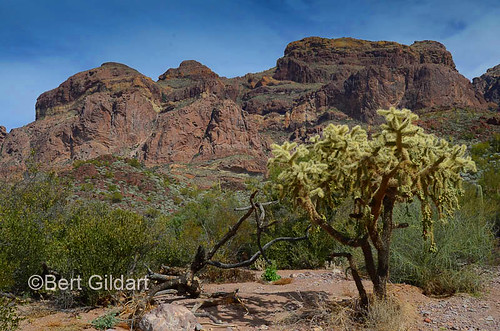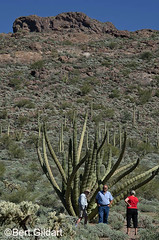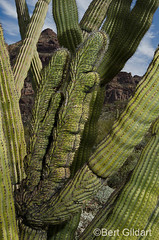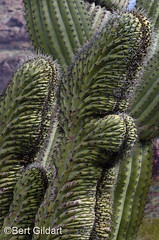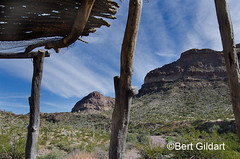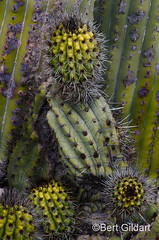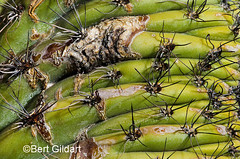Organ Pipe’s Ajo Mountain Loop – Recalling the Sounds of Silence
©Bert Gildart: Two days ago I rode my bicycle along Organ Pipe’s National Monuments Ajo Mountain loop road. It is a 21-mile long gravel road, and though vehicular traffic is permitted, at this time of year it is sparse. During my entire ride I saw less than a dozen cars.
But the point is that the silence was intense, and there are few other places Janie and I have visited where we could stop and say, “Listen! What do you hear?” The answer was nothing. Absolutely nothing; and that is an observation we’ve been able to make in but few other settings.
Glacier National Park is one, and so is the Arctic National Wildlife Refuge. But there was yet more about this isolated area of the park that thrilled me: It is the heart of the Sonoran Desert, and though Janie has seen it before, we decided yesterday that we’d travel it again, but this time with lots of camera gear. As a result, I am now able to post these images, and with them some thoughts about why I took them.
L TO R: All images show organ pipe, but the last two in this row show a bizarre structure biologists call a “cristates.”
Appropriately, the first picture summarizes the drive. It is, after all, the Ajo Mountain Drive so the top image portrays Ajo Mountain. Just beyond the mountain is the Tohono O’odham Indian Reservation, and once members of the tribe made a living from the lands setting up ramadas near water sources, such as seen in another image. The park interprets their tenure in the park with the construction of a ramada set up on a bank overlooking Diablo Wash. Nearby, lands are ideal for the growth of both the saguaro and the organ pipe, both of which the O’odham harvested. Using the woody ribs of dead saguaros to create a tool they called a kupit, the tribe plucked fruit from the spiny columns and arms of the Sonoran’s two most conspicuous species those being, of course, the organ pipe and the saguaro.
Though the two trees share a similar environment, they begin life differently. Saguaro begins in the shade of a palo verde — or in the shade of one of the other “bean plants” that grows here, such as the mesquite. But not so the organ pipe, which requires more heat, and sometimes that comes from an association with volcanic rock.
Also of interest is the fact the organ pipe (and the saguaro) sometimes produces a bizarre formation called a crest, and on the day of my bike ride a group of Canadians pointed out the structure to me. In turn, I wanted Janie to see it, and I needed her to hold one of the strobe lights necessary to eliminate harsh shadows. I wanted her “to hear” the silence.
L to R: Ramada overlooking Diablo Wash; new (the yellow) arms emerging from organ pipe; close up of cristates.
Cristates is another name used to describe the unusual growth patterns and though the shape is common, scientists are at a loss to explain their existence. Some, according to a park brochure, say the growth results from genetics. Others believe it could be frost while yet others say the pattern results from imbalance in growth hormones. Though there is much to be said for understanding, there’s also much to be said for aesthetics, and the organ pipe with all of its shapes and peculiarities satisfies the complex issue of simple beauty.
My last images show the beginning of new arms on an organ pipe. Again, these structures add to the paragon of the Sonoran, and that status along with the silence Janie and I experienced on this my second tour has elevated Organ Pipe to a place of simple quiet beauty that should not be missed.
———————————-
THIS TIME SIX YEARS AGO:
*Airstream Camper Tips from Organ Pipe
————–
BOOKS FOR SALE:
4th ed. Autographed by the Authors
Hiking Shenandoah National Park
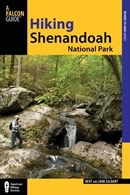 Hiking Shenandoah National Park is the 4th edition of a favorite guide book, created by Bert & Janie, a professional husband-wife journalism team. Lots of updates including more waterfall trails, updated descriptions of confusing trail junctions, and new color photographs. New text describes more of the park’s compelling natural history. Often the descriptions are personal as the Gildarts have hiked virtually every single park trail, sometimes repeatedly.
Hiking Shenandoah National Park is the 4th edition of a favorite guide book, created by Bert & Janie, a professional husband-wife journalism team. Lots of updates including more waterfall trails, updated descriptions of confusing trail junctions, and new color photographs. New text describes more of the park’s compelling natural history. Often the descriptions are personal as the Gildarts have hiked virtually every single park trail, sometimes repeatedly.
Big Sky Country is beautiful
Montana Icons: 50 Classic Symbols of the Treasure State
![]() Montana Icons is a book for lovers of the western vista. Features photographs of fifty famous landmarks from what many call the “Last Best Place.” The book will make you feel homesick for Montana even if you already live here. Bert Gildart’s varied careers in Montana (Bus driver on an Indian reservation, a teacher, backcountry ranger, as well as a newspaper reporter, and photographer) have given him a special view of Montana, which he shares in this book. Share the view; click here.
Montana Icons is a book for lovers of the western vista. Features photographs of fifty famous landmarks from what many call the “Last Best Place.” The book will make you feel homesick for Montana even if you already live here. Bert Gildart’s varied careers in Montana (Bus driver on an Indian reservation, a teacher, backcountry ranger, as well as a newspaper reporter, and photographer) have given him a special view of Montana, which he shares in this book. Share the view; click here.
$16.95 + Autographed Copy
What makes Glacier, Glacier?
Glacier Icons: 50 Classic Views of the Crown of the Continent
![]() Glacier Icons: What makes Glacier Park so special? In this book you can discover the story behind fifty of this park’s most amazing features. With this entertaining collection of photos, anecdotes and little known facts, Bert Gildart will be your backcountry guide. A former Glacier backcountry ranger turned writer/photographer, his hundreds of stories and images have appeared in literally dozens of periodicals including Time/Life, Smithsonian, and Field & Stream. Take a look at Glacier Icons
Glacier Icons: What makes Glacier Park so special? In this book you can discover the story behind fifty of this park’s most amazing features. With this entertaining collection of photos, anecdotes and little known facts, Bert Gildart will be your backcountry guide. A former Glacier backcountry ranger turned writer/photographer, his hundreds of stories and images have appeared in literally dozens of periodicals including Time/Life, Smithsonian, and Field & Stream. Take a look at Glacier Icons
$16.95 + Autographed Copy
